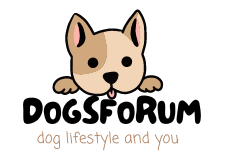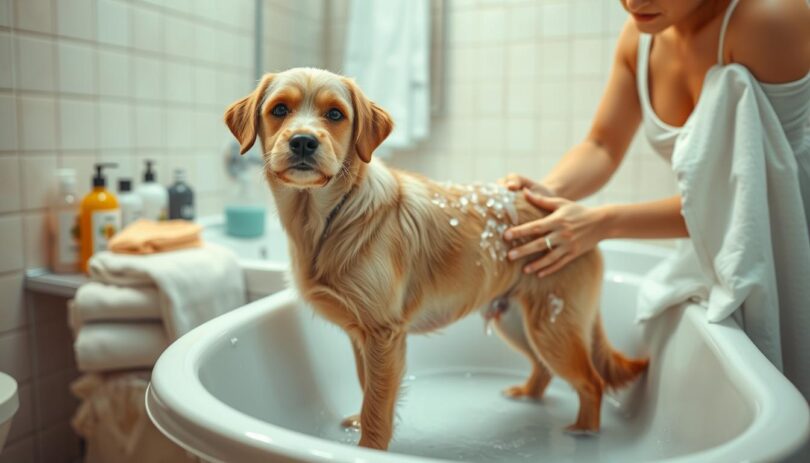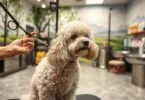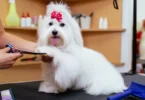Did you know only 56% of dog owners bathe their pets regularly? Learning how to wash your dog at home can greatly improve their health and cleanliness.
Dog grooming is more than just keeping them clean. It's essential for their well-being. Vets suggest bathing dogs once a month, based on their breed, lifestyle, and needs.
This guide will cover everything you need to know about dog washing. We'll show you how to pick the right shampoo and master the bathing process. It's all about making bath time a positive experience for you and your dog.
Good pet bathing is more than just cleaning. It helps spot health problems early, controls shedding, and keeps your dog's skin and coat healthy.
If you're new to pet ownership or want to improve your grooming skills, this guide is for you. It offers expert tips to make bath time easy and fun, ensuring your dog stays healthy and happy.
Importance of Regular Dog Washing
Regular dog washing is more than just keeping them clean. It's key to your pet's health and happiness. Experts say washing your dog often helps avoid health problems and keeps them looking and feeling great.
Health Benefits of Regular Bathing
Good grooming stops serious health issues. Severe hair mats can cut off blood flow and cause harm. Washing your dog regularly removes dead hair and improves their coat's shine.
For dogs with skin problems, baths are a must. They help treat these issues.
Behavioral and Hygiene Impacts
Dog wash services know grooming does more than just make them look good. It cuts down on shedding and finds skin problems early. It also spots fleas and ticks.
Clean dogs feel better and are more confident. Groomers suggest washing based on your dog's breed and needs. Long-haired dogs need grooming every 4-6 weeks, while short-haired ones can go 8-12 weeks.
By focusing on your dog's hygiene, you're making a big investment in their health and happiness.
Choosing the Right Dog Wash Supplies
Getting ready for a dog bath means picking the right tools and supplies. Quality equipment makes bathing comfortable for you and your pet. It's all about making the experience smooth.
Essential Bathing Tools and Equipment
For a mobile dog wash station, you'll need some key items. A good dog wash sprayer costs between $40 to $75. The Dura Faucet RV Handheld Shower Sprayer, at $40, saves water with its on/off switch.
The Reege Dog Grooming Sprayer, priced at $39, has a water control lever like a garden hose.
Selecting the Best Dog Shampoo
Choosing the right dog shampoo is key for your pet's skin health. Dogs have different skin pH than humans, so they need special shampoo. Look for mild, hypoallergenic formulas made for dogs.
Avoid human shampoo, as it can irritate your dog's skin and upset their natural balance.
Optional Bathing Products to Consider
Consider adding detangling sprays, ear cleaners, and paw balms to your dog wash routine. These products can make grooming easier and keep your dog clean. A well-stocked mobile dog wash setup meets your pet's grooming needs.
Preparing for the Dog Wash
Getting ready for bath time is key to a good experience for your dog. With 45% of dog owners saying their pets get anxious during baths, it's important to prepare well. You want to make a calm, comfy space for your dog to feel safe.
Before you start, collect all your supplies near the dog wash area. This could be your home bathroom or a self-serve dog wash station. Being organized helps reduce stress for both you and your pet.
Creating a Comfortable Environment
Find a warm, draft-free spot for bathing. If using dog wash stations, pick a clean, well-lit area with non-slip floors. At home, use a non-slip mat in the bathtub or washing area. Keep the room at a comfortable temperature to avoid your dog getting cold.
Easing Your Dog's Anxiety
About 90% of dog owners find treats make baths better. Use positive methods like giving treats, speaking softly, and praising gently. Let your dog get used to the dog wash area first, without water, to make it a positive experience.
Gathering Necessary Supplies
Make a bath kit with dog-safe shampoo, towels, brushes, and treats. Keep everything close to avoid any hiccups during the bath. Remember, 80% of dog owners use dog-safe shampoo to avoid skin problems, so pick the right products.
Techniques for Bathing Your Dog
Professional dog grooming needs a lot of care and knowing what your dog needs. Each dog is different, based on breed, coat, and personality. Learning how to bathe your dog right keeps them clean, comfy, and healthy.
Step-by-Step Bathing Guide
First, get all your supplies ready and make sure the area is non-slip. Wet your dog's fur all the way from the neck to the tail. Use warm water and don't spray it on their head.
Dogs are sensitive around their face. So, use a damp cloth for cleaning there.
Best Practices for Rinsing and Drying
It's important to rinse your dog well in dog grooming. Shampoo left on can irritate their skin. Dry them with multiple towels, focusing on spots where water might stay.
Short-haired dogs dry faster than long-haired ones.
Handling Different Dog Sizes
Dog grooming services adjust for different sizes. Small dogs need gentle care, while big ones use more water and shampoo. Speak softly and give treats to make it a good experience.
Most dogs should only be bathed once a month. This helps keep their natural oils.
Common Dog Washing Mistakes to Avoid
Pet bathing can be tricky, and many dog owners unknowingly make mistakes. These mistakes can affect their furry friend's comfort and health. Knowing these common errors in dog grooming can make bath time better for both you and your pet.
Overusing Water and Shampoo
Using too much water or shampoo can cause serious problems. Too much water can irritate your dog's skin. Too much shampoo can remove natural oils from their coat. Professional groomers say to use just enough product to clean without overwhelming your pet's sensitive skin.
Neglecting Sensitive Areas
Dog grooming needs careful attention to sensitive areas like ears, eyes, and paw pads. Water in a dog's ears can cause infections because of their ear shape. Always protect these areas during pet bathing by using cotton balls and being extra gentle.
Skipping the Reward Process
Creating a positive association with bath time is key in dog grooming. Many owners forget to reward their pets after washing. This can make future baths stressful. Use treats, praise, and gentle handling to make bath time enjoyable for your dog.
Remember, consistent and careful pet bathing techniques will help keep your dog healthy. It will also strengthen your bond during grooming sessions.
Post-Bath Care and Maintenance
After washing your dog, keeping them clean is important. Brushing and grooming help a lot. They keep your dog's coat healthy and shiny.
How often you wash your dog depends on their breed, coat, and how active they are. Short-haired dogs need baths every 6-8 weeks. Long-haired dogs and active dogs might need baths more often.
Look for signs your dog needs a bath, like dirt, bad smells, or skin problems. Keep an eye on how their coat looks. Good hygiene means more than just cleaning. It's about keeping their skin and fur healthy too.
Use dog shampoo and brush gently to avoid tangles. A low-heat dryer and positive words make the bath better for everyone.











Leave a Comment